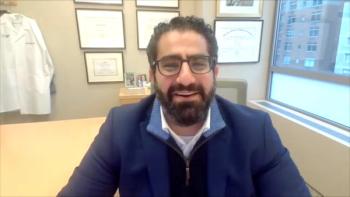
- January 2017
- Volume 23
- Issue SP1
Healthcare Costs and Utilization After First-Line Therapy for Medicare DLBCL Patients
Patients diagnosed with diffuse large B-cell lymphoma (DLBCL) who relapsed following first-line treatment had higher rates of healthcare utilization and greater costs than the patients who had not relapsed.
A COMPARISON OF MEDICARE
claims for patients with diffuse large B-cell lymphoma (DLBCL) after first-line treatment found that the patients who relapsed had higher rates of healthcare utilization and greater costs than the patients who had not relapsed. The research, presented at the American Society of Hematology’s 58th Annual Meeting & Exposition, suggests that improvements in first-line DLBCL therapy can offer “significant healthcare savings in addition to improved clinical outcomes.”1
Recent study results on patients with non-Hodgkin lymphoma have indicated that the average costs for those on active treatment were $5871 per patient per month versus $355 for control patients during a 2-year follow-up period.2 DLBCL, an aggressive subtype of non-Hodgkin’s lymphoma, has relatively high rates of relapse after initial treatment, but there is limited research on treatment patterns post first-line therapy and the healthcare costs associated with relapses. As such, the study authors set out to measure healthcare utilization and costs after the completion of first-line DLBCL therapy.
The retrospective study was conducted by gathering Medicare claims data and selecting adults over age 65 who had received their first time DLBCL diagnosis between January 1, 2010, and June 30, 2014. The researchers created a study cohort of patients receiving post first-line therapy by defining the end of first-line treatment as a gap of over 60 days in therapy. The relapsed group consisted of beneficiaries who then initiated second-line therapy, while the nonrelapsed group was made up of individuals who completed the first-line therapy without receiving any other chemotherapy treatment.
Of the 5909 beneficiaries, 1552 had claims data for second-line therapy during the follow up period, while the remaining 4357 did not. The relapsed and nonrelapsed groups had similar mean ages and other baseline characteristics, although there were differences in first-line treatment between the 2 groups. The patients who had relapsed were more likely to have received rituximab monotherapy, bendamustine-rituximab, or CVP (cyclophosphamide, vincristine, and prednisone) regimens, while the nonrelapsed patients were more likely to have received R-CHOP (cyclophosphamide, doxorubicin, vincristine, and prednisone) for first-line therapy. Mean follow-up time after first-line therapy was similar between the 2 cohorts.
Analysis of the claims data found that the relapsed cohort had significantly higher healthcare utilization after first-line therapy compared with the nonrelapsed patients. The most pronounced difference was in rates of inpatient hospital admissions: the relapsed cohort had claims in 60.7% of cases compared with 41.1% of the nonrelapsed group. The relapsed group also had a mean of 37.93 follow-up outpatient visits per patient per year compared with 24.75 per patient per year in the nonrelapsed group. And the relapsed group had significantly higher rates of emergency department visits, Medicare Part D pharmacy claims, and use of skilled nursing facility, home health agency, and hospice services.
These increases in utilization were unsurprisingly linked to higher mean all-cause healthcare costs. The relapsed cohort was responsible for total healthcare costs of $4848 per patient per month, more than 3 times higher than the $1427 in costs among nonrelapsed patients. The major cost drivers of this disparity among the patients who had relapsed compared with the nonrelapsed group were total outpatient care ($2984 vs $632) and inpatient costs ($1220 vs $443). Among relapsed patients, the total costs from the date of relapse to the end of the study were double the costs during remission. In addition to limitations of assessing claims data, the authors indicate that 1674 patients who died within 12 months of index data were excluded from the study, which included 29.8% of patients in the relapsed cohort and 21.4% in the nonrelapsed cohort.
“Our study confirms healthcare utilization is significantly higher in older adults who progress after first-line therapy for DLBCL compared to those without disease relapse,” said lead study author Scott Huntington, MD, MPH, MSHP, assistant professor at Yale University School of Medicine’s Section of Hematology, in an e-mail response to Evidence-Based Oncology™. “Thus, improvements in first-line DLBCL treatment that increase durable remissions are likely to offer significant healthcare savings in addition to improved clinical outcomes. These findings may be particularly helpful for informing value-based drug pricing in the future.” REFERENCES
- Huntington SF, Keshishian A, Xie L, Baser O, McGuire M. Evaluating the economic burden and health care utilization following first-line therapy for Diffuse Large B-cell lymphoma patients in the US Medicare population. Presented at the 58th American Society of Hematology Annual Meeting & Exposition, December 3, 2016, San Diego, California. Abstract 3574.
- Byfield SD, Small A, Becker LK, Reyes CM. Differences in treatment patterns and health care costs among non-Hodgkin’s lymphoma and chronic lymphocytic leukemia patients receiving rituximab in the hospital outpatient setting versus the office/clinic setting. J Cancer Ther. 2914;5(4):208-216. doi: 10.4236/jct.2014.52026.
Articles in this issue
almost 9 years ago
Innovative Approach to Precision Trial Design: NCI-MATCH and Beat AMLalmost 9 years ago
ASH "Choosing Wisely Champions" Share Their Practice-Changing Successalmost 9 years ago
How Soon Will Pluripotent Stem Cells Find Clinical Utility?Newsletter
Stay ahead of policy, cost, and value—subscribe to AJMC for expert insights at the intersection of clinical care and health economics.
















































